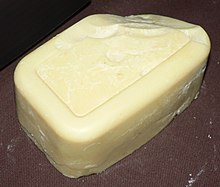Cocoa butter

Raw cocoa butter
|
|
| Fat composition | |
|---|---|
| Saturated fats | |
| Total saturated | 57–64%: stearic acid (24–37%), palmitic acid (24–30%), myristic acid, (0–4%), arachidic acid (1%), lauric acid (0–1%) |
| Unsaturated fats | |
| Total unsaturated | 36–43% |
| Monounsaturated | 29–43%: oleic acid (29–38%), palmitoleic acid (0–2%) |
| Polyunsaturated | 0–5%: linoleic acid (0–4%), α-Linolenic acid (0–1%) |
| Properties | |
| Food energy per 100 g (3.5 oz) | 3,699 kilojoules (884 kcal) |
| Melting point | 34.1 °C (93.4 °F), 35–36.5 °C (95.0–97.7 °F) |
| Solidity at 20 °C (68 °F) | solid |
| Refractive index | 1.44556–1.44573 |
| Iodine value | 32.11–35.12, 35.575 |
| Acid value | 1.68 |
| Saponification value | 191.214, 192.88–196.29 |
Cocoa butter, also called theobroma oil, is a pale-yellow, edible vegetable fat extracted from the cocoa bean. It is used to make chocolate, as well as some ointments, toiletries, and pharmaceuticals. Cocoa butter has a cocoa flavor and aroma. Its best-known attribute is its melting point, which is just below human body temperature.
Cocoa butter is obtained from whole cocoa beans, which are fermented, roasted, and then separated from their hulls. About 54–58% of the residue is cocoa butter. Chocolate liquor is pressed to separate the cocoa butter from the cocoa solids. The Broma process is used to extract cocoa butter from ground cacao beans. Cocoa butter is sometimes deodorized to remove strong or undesirable tastes.
Cocoa butter contains a high proportion of saturated fats, derived from stearic and palmitic acids. Cocoa butter, unlike cocoa solids, has no more than trace amounts of caffeine and theobromine.
Some food manufacturers substitute less expensive materials such as vegetable oils and fats in place of cocoa butter. Several analytical methods exist for testing for diluted cocoa butter. Adulterated cocoa butter is indicated by its lighter color and its diminished fluorescence upon ultraviolet illumination. Unlike cocoa butter, adulterated fat tends to smear and have a higher non-saponifiable content.
Cocoa butter is becoming increasingly expensive. Substitutes have been designed to use as alternatives. In the United States, 100% cocoa butter must be used for the product to be called chocolate. The EU requires that alternative fats not exceed 5% of the total fat content.
Fats used for this purpose include: Cocoa Butter Substitute – coconut oil or palm oil; Cocoa butter Replacer – soybean oil, rapeseed oil and cottonseed oil; Cocoa Butter Equivalent – shea butter, illipe, sal nut, palm, mango kernel fat, palm oils, and PGPR.
...
Wikipedia
